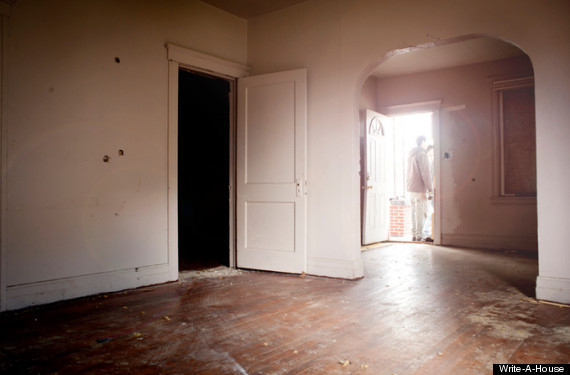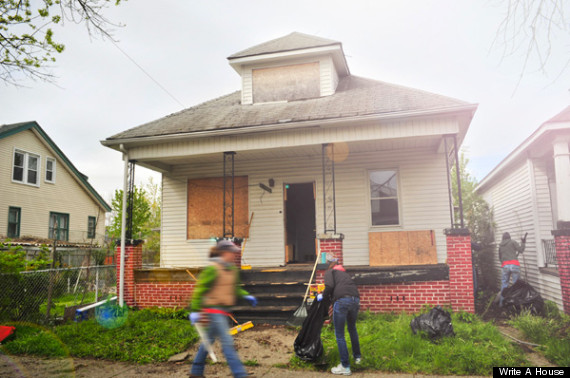Harold Rhenisch's place
 |
| Harold Rhenisch in Iceland |
If you look up "prolific" in the dictionary, you'll find Harold Rhenisch's picture there. Or you should. He's written four books of creative non-fiction, fourteen collections of poetry, a novel, and numerous chapbooks. He's written short stories and plays and acted as a translator and editor. Harold's The Wolves at Evelyn: Journeys through a Dark Century (Brindle
and Glass, 2007) won the George Ryga Award for Social Responsibility in
British Columbia Literature. His love of the land, especially the BC interior, resonates in his writing. You can read more about Harold
here.
Klaustrid
Artist’s Residency
 |
| The residence is in the upper right corner of the building. |
The Skriðuklaustur Cultural Centre puts out a call every year for artistic, literary or scholarly projects that will be
created and presented onsite in North East Iceland, 35 kilometres outside of the nearest
town, Egilsstaðir. It is an old monastery site, at the head of the old mountain pass to
the south. There is all the isolation one could wish for, plus a comfortable one bedroom
studio in the corner of a sprawling house and museum with a complex historical past.
From March 25 to April 21, I will be working there, on a project
about the builder of the site, the Icelandic writer Gunnar Gunnarsson, but, really, it’s
about a lot more than that. It’s about being indigenous and about forms of writing and
word-wrighting that preceded literature by thousands of years and do not take part in its
projects. In 1940, Gunnarsson toured Germany on a reading tour, as
part of the Nazi puppet organization, The Nordic League, as the culmination of decades of
work advocating for a Unified Scandinavian State as a
counterbalance for what he saw as the growing, and dangerous, dominance of
German and French affairs in Europe. At the end of the tour, he had a personal audience
with Hitler, a fact which likely cost him the Nobel Prize, three times. The house was
built by Fritz Höger, the architect who Speer beat out in the competition for chief
architect of the Third Reich. That’s complicated. Or, really, it’s very simple.
In his 1940s tour, Gunnarsson read a prepared, poetic speech about
the landscape of
Iceland. More than anything, it appears to have been an attempt to
use his great literary
fame to keep
Germany out of Iceland. The house was built for his return to Iceland after almost thirty years in
Denmark. He intended it to be a model farm, in the German manner, to teach modern
farming methods to the Icelanders, so that they could gain financial independence from
their Danish overlords. The high wages that the British and American Navies were paying
for labourers put an end to this somewhat out-dated dream, and
Iceland entered the modern world without him. This is my story, too. I was
raised in that dream, although in Canada, not Iceland. That is my country,
though.
Of all the writers in the world, there can’t be more than a few of
us who grew up in the
German Nordic and agricultural dream that was swallowed up by the
increasing brutalization of Nazism and the horrors of the Second
World War, and of all of those, perhaps only one who is both a
poet, who can read between the lines of Gunnarsson’s speech, and
an experimental, cross-genre nonfiction writer, who can write about the
innovation that was Gunnarsson’s fiction, that wasn't really fiction but a
skillful form of political agitation eighty and even a hundred
years ahead of its time. What poet couldn't love this country?
I visited Gunnarsson’s house, and thought at first that with my
past there is no way I could write there. Other people could, but
for me, with my complex and troubled German past, the pain would
be too deep. I knew too much about what I was looking at. Then I
realized that I need only confront it head on, to heal it. That’s my project.
It will be a mix of prose, history, criticism, landscape work,
visual poetry built on Icelandic runes, spellcraft and maps,
poetry built on Old Norse, and photography. English is a much evolved
form of Old Norse, while Icelandic is Old Norse itself, scarcely changed over
time. There is magic in those old roots of language, and old technologies, such
as the technology of the line, which is a technology of balance
and will, that shows up in the rope, the halter, the fence, the thread,
the skein, the net, the sweater, the scythe, and soon — a deeply
physical magic, at any rate. The Old Norse vocabulary in English, with its
ability to move from verb to noun and back again, and the Anglo Saxon that
followed it, and those old technologies, will be central to my
task. When I first visited Iceland, I knew I had come home. What
is one to do with such knowledge? Go to the monastery in the
Northeast, perhaps, and make the old ways new.
When I first came to Iceland, I had just finished my second tour
of the Northern Camino, the via
regia, the old Salt Road
between Frankfurt and Leipzig, straight through the darkness of
the German forest. The man who set out east the first time became a
pilgrim, unintentionally, and then never came back. I went back to find him and
bring him home, and did, except, irony of ironies, he was the one,
an East German now, who came. Harold, the Canadian writer, who
first started out, was left behind in Buchenwald. The book about
that is still in the writing, nearly done. It’s in two versions, the completed
third part of Faust, and a series of pilgrim’s tales and gardens, of both light
and dark magic, still in the writing. Before I publish it, I want
to see how the parts talk to each other. Luckily, on my way home I
landed in Iceland.
I’m not going to Skriðuklaustur to find a congenial or challenging
space in which to write. Writing comes as a gift, and I have
learned to be open to it. I’m going there so that my new self,
which is the same as the oldest one I bore before literacy tore me away
from the world, has a chance to breathe and grow stronger in its own place,
among its people in all their complexity — the trolls and elves
and the humans who speak its language. The price for this journey
has been that I lost Canada. I don’t live there anymore. It’s the
strangest thing. I have a renewed and deepened tie to my land, the
Okanagan of the Columbia Plateau, and the Plateau itself, but Canada? I lost
that in No Man’s Land, when I realized that there is a story, an
old story, that I know it intimately, and it is not being told. It
has been given to me from the past to tell, and it is vitally important
that I tell it. No one else can. And it must be told, to heal a great darkness
and to keep something important alive. I’m stepping out into the
unknown, and yet, I feel that I know it well. I just have to let
the words for it come. I expect Klaustrid to be an experience of
my body, and I intend to listen.







